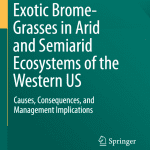Invasive Species
View fact sheet, pg. 12.
This fact sheet provides managers with tools and strategies to reestablish perennial-dominated plant communities in medusahead-invaded sagebrush rangelands.
View all topics reviewed in the Fact Sheet series.
View fact sheet.
Land managers are increasingly interested in improving resilience to disturbances,such as wildfire, and resistance to invasive species,such as cheatgrass and medusahead. This fact sheet is designed to assist land managers in resilience and resistance concepts to assess risks, prioritize management activities, and select treatments.
This is the first of many topics reviewed in the Great Basin Fact Sheet series.
Individual fact sheets comprising the Information and tools to conserve and restore Great Basin ecosystems – Factsheet Series are available below.
No. 1- Putting resilience and resistance into practice
No. 2- Limiting medusahead invasion and impacts in the Great Basin
No. 4- Conifer removal in the sagebrush steppe: The why, when, where, and how
No. 6- Wind erosion following wildfire in Great Basin ecosystems
No. 7- Post-fire grazing management in the Great Basin
No. 8- Establishing big sagebrush and other shrubs from planting stock
No. 9- Assessing fuel loads in sagebrush steppe and PJ woodlands
No. 10- Seeding big sagebrush successfully on Intermountain rangelands
No. 11- Assessing impacts of fire and post-fire mitigation on runoff and erosion from rangelands
No. 12- Management of aspen in a changing environment
No. 13- Woody fuels reduction in Wyoming big sagebrush communities
No. 14- Seeding techniques for sagebrush community restoration after fire

The book, Exotic brome-grasses in arid and semiarid ecosystems of the western US: causes, consequences, and management implications, is presented in several chapters.
Access is provided for the following chapters -
Chapter 1 - Introduction: Exotic annual Bromus in the western USA
Chapter 2 - Exotic annual Bromus invasions: comparisons among species and ecoregions in the western US
Chapter 3 - Ecosystem impacts of exotic annual invaders in the genus Bromus
Chapter 7 - Community ecology of fungal pathogens on Bromus tectorum
Chapter 8 - Soil moisture and biogeochemical factors influence the distribution of annual Bromus species
Chapter 9 - Bromus response to climate and projected changes with climate change
Chapter 10 - Plant community resistance to invasion by Bromus species: The roles of community attributes, Bromus interactions with plant communities, and Bromus traits
Chapter 11 - Land uses, fire, and invasion: Exotic annual Bromus and human dimensions
Chapter 12 - Assessing restoration and management needs for ecosystems invaded by exotic annual Bromus species
View webinar recording.
Cheatgrass and medusahead invasions pose a serious threat to Great Basin ecosystems. Managers and scientists are hopeful that strains of the bacterium Pseudomonas fluorescens will be able to selectively inhibit root growth of annual weeds in more complex rangeland ecosystems. These weed-suppressive bacteria (WSB) are now commercially available in many states and have been applied on tens of thousands of acres across the Great Basin, yet results are variable and largely unpublished, indicating that much remains to be understood about when, where and why WSB are or are not effective. This webinar features six speakers: Matt Germino, USGS and Great Basin LCC; David Pyke, USGS; Richard Lee, BLM; Mike Gregg, USFWS; Jane Mangold, Montana State University, and Brynne Lazarus, USGS.
This webinar presents an overview of how to understand what weeds are and are not included in weed testing for seed that is sold in industry or increased under contract, and presents tools to help determine what weeds are actually present in seed procured by the end-user. A seed ordering guidance paper will also be made available. Presented by Steve Popovich, Emergency Stabilization and Rehabilitation National Program Lead, BLM, Washington D.C.
View webinar recording.
Bruce Wylie and Stephen Boyte, USGS, discuss their recent research mapping herbaceous annual cover in the Great Basin. This webinar was hosted by the Great Basin LCC.
- Restoring & managing “Emerald Isles”
- Strategic, multi-scale approach for managing threats to sagebrush ecosystems based on resilience and resistance concepts
The Society for Range Management’s 71st Annual Meeting, Technical Training and Trade Show was at the Nugget Hotel in Sparks, Nevada. The theme for the 2018 conference was Empowerment through Applied Science.
Course Description: Functional responses and adaptations of individual species to their environment, emphasizing the physiological mechanisms that influence the interactions between organisms and the major environmental factors (e.g., solar radiation, energy balance, temperature, water and nutrients, climate), and how this affects the interactions among species and their growth and survival (e.g., competition, herbivory, and allelopathy). Interactive computer-based learning materials are used extensively.
Prerequisites: A course in general ecology (e.g., Ecology NR 321), general botany or plant physiology, or permission.
Recommended preparation: Review of plant physiology
Computer compatibility: The course learning materials are compatible only with computers that are 100% compatible with the Windows operating system and the browser, Internet Explorer.
This webinar presents an overview to understanding what weeds are and are not included in agricultural straw/mulch certified under Weed-Free Forage programs by states and the North American Invasive Species Management Association (NAISMA). It presents simple steps the user can take to make informed decisions when acquiring mulch to assess and minimize weed presence, including office and field tips. Alternative sources to agricultural mulch and relative costs are also discussed. Presented by Steve Popovich, Forest Botanist and Rare and Invasive Species Program Manager, USFS, Ft. Collins, CO.

